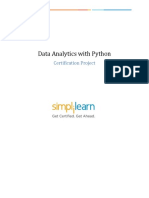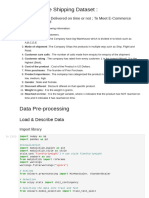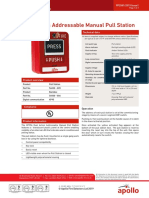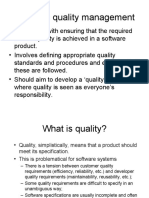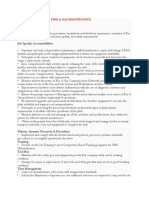Aerofit_Case_Study
Uploaded by
Raja SinghAerofit_Case_Study
Uploaded by
Raja SinghAerofit Business Case Study
Data
The analysis was done on the data located at -
https://d2beiqkhq929f0.cloudfront.net/public_assets/assets/000/001/125/original/aerofit_treadmill.csv
Libraries
Below are the libraries required for analysing and visualizing data
In [1]: # libraries to analyze data
import numpy as np
import pandas as pd
# libraries to visualize data
import matplotlib.pyplot as plt
import seaborn as sns
Data loading and initial analysis
Loading the data into Pandas dataframe for easily handling of data
In [2]: # read the aerofit_treadmill.csv file into a pandas dataframe
df = pd.read_csv('aerofit_treadmill.csv')
# look at the datatypes of the columns
print(df.info())
print('*************************************************\n')
print(f'Shape of the dataset is {df.shape}')
print('*************************************************\n')
print(f'Number of nan/null values in each column: \n{df.isna().sum()}')
print('*************************************************\n')
print(f'Number of unique values in each column: \n{df.nunique()}')
<class 'pandas.core.frame.DataFrame'>
RangeIndex: 180 entries, 0 to 179
Data columns (total 9 columns):
# Column Non-Null Count Dtype
--- ------ -------------- -----
0 Product 180 non-null object
1 Age 180 non-null int64
2 Gender 180 non-null object
3 Education 180 non-null int64
4 MaritalStatus 180 non-null object
5 Usage 180 non-null int64
6 Fitness 180 non-null int64
7 Income 180 non-null int64
8 Miles 180 non-null int64
dtypes: int64(6), object(3)
memory usage: 12.8+ KB
None
*************************************************
Shape of the dataset is (180, 9)
*************************************************
Number of nan/null values in each column:
Product 0
Age 0
Gender 0
Education 0
MaritalStatus 0
Usage 0
Fitness 0
Income 0
Miles 0
dtype: int64
*************************************************
Number of unique values in each column:
Product 3
Age 32
Gender 2
Education 8
MaritalStatus 2
Usage 6
Fitness 5
Income 62
Miles 37
dtype: int64
A quick look at the information of the data reviles that there are 180 rows and 9 columns implying 180
products have been sold to different customers with information of each customer like age, gender, income
to name a few. The datatype of product, gender and marital status is “object” and rest is of int64 datatype.
We can also infer that there are no missing values or nulls in the dataset. \ \ A smaple of the data is shown
below:
In [3]: # look at the top 5 rows
df.head()
Out[3]: Product Age Gender Education MaritalStatus Usage Fitness Income Miles
0 KP281 18 Male 14 Single 3 4 29562 112
1 KP281 19 Male 15 Single 2 3 31836 75
2 KP281 19 Female 14 Partnered 4 3 30699 66
3 KP281 19 Male 12 Single 3 3 32973 85
4 KP281 20 Male 13 Partnered 4 2 35247 47
In [4]: df.describe()
Out[4]: Age Education Usage Fitness Income Miles
count 180.000000 180.000000 180.000000 180.000000 180.000000 180.000000
mean 28.788889 15.572222 3.455556 3.311111 53719.577778 103.194444
std 6.943498 1.617055 1.084797 0.958869 16506.684226 51.863605
min 18.000000 12.000000 2.000000 1.000000 29562.000000 21.000000
25% 24.000000 14.000000 3.000000 3.000000 44058.750000 66.000000
50% 26.000000 16.000000 3.000000 3.000000 50596.500000 94.000000
75% 33.000000 16.000000 4.000000 4.000000 58668.000000 114.750000
max 50.000000 21.000000 7.000000 5.000000 104581.000000 360.000000
The above table shows the statistics of the data like mean, minimum and maximum value. As we can see
there is a large spread in the Icome and Miles data.
Analysis
Detecting outliers
a. Outliers for every continuous variable
In [5]: # helper function to detect outliers
def detectOutliers(df):
q1 = df.quantile(0.25)
q3 = df.quantile(0.75)
iqr = q3-q1
outliers = df[(df<(q1-1.5*iqr)) | (df>(q3+1.5*iqr))]
return outliers
In [6]: numerical_columns = ['Age', 'Education', 'Usage', 'Income', 'Miles']
num_of_outliers_per_column = []
for column in numerical_columns:
print(f'Outliers of \'{column}\' column are:')
outliers = detectOutliers(df[column])
print(outliers)
num_of_outliers_per_column.append(len(outliers))
Outliers of 'Age' column are:
78 47
79 50
139 48
178 47
179 48
Name: Age, dtype: int64
Outliers of 'Education' column are:
156 20
157 21
161 21
175 21
Name: Education, dtype: int64
Outliers of 'Usage' column are:
154 6
155 6
162 6
163 7
164 6
166 7
167 6
170 6
175 6
Name: Usage, dtype: int64
Outliers of 'Income' column are:
159 83416
160 88396
161 90886
162 92131
164 88396
166 85906
167 90886
168 103336
169 99601
170 89641
171 95866
172 92131
173 92131
174 104581
175 83416
176 89641
177 90886
178 104581
179 95508
Name: Income, dtype: int64
Outliers of 'Miles' column are:
23 188
84 212
142 200
148 200
152 200
155 240
166 300
167 280
170 260
171 200
173 360
175 200
176 200
Name: Miles, dtype: int64
In [7]: for column in numerical_columns:
sns.boxplot(data=df[column])
plt.title(column)
plt.show()
In [8]: for idx in range(len(numerical_columns)):
print(f'The column \'{numerical_columns[idx]}\' has {num_of_outliers_per_column[idx]
The column 'Age' has 5 outliers
The column 'Education' has 4 outliers
The column 'Usage' has 9 outliers
The column 'Income' has 19 outliers
The column 'Miles' has 13 outliers
b. Clip data between 5 and 95 percentile
In [9]: for column in numerical_columns:
clip_min = df[column].quantile(0.05)
clip_max = df[column].quantile(0.95)
df[column] = np.clip(df[column], clip_min, clip_max)
The data is limited between the 5 and 95 percentile of each column so as to avoid any bias during analysis
Effect of customer features on product purchased
a. Relationship between the categorical variables and the product
models.
In [10]: categorical_columns = ['Gender', 'MaritalStatus', 'Fitness']
for column in categorical_columns:
sns.countplot(data=df, x = column, hue='Product')
plt.show()
Both the male and female customers prefer the product KP281. In case of female customers, we can see
that majority of them prefer KP281 followed by KP481 and KP781 is the least prefered product among
females \ Partnered customers tend to buy more products compared to Single customers across all
product models \ Majority of the people have rated themselves moderate fitness. Interestingly, people
who have bought the advanced level treadmill, KP781, have rated themselves high fitness.
b. Relationship between the continuous variables and the product
models.
In [11]: sns.scatterplot(data=df, x = 'Age', y = 'Income', hue='Product', size='Miles', style='Fi
plt.legend(bbox_to_anchor=(1.05, 1), loc='upper left', borderaxespad=0)
plt.show()
sns.histplot(data=df, x='Age', hue='Product', multiple="stack")
plt.show()
sns.histplot(data=df, x='Education', hue='Product', multiple="stack")
plt.show()
sns.histplot(data=df, x='Income', hue='Product', multiple="stack")
plt.show()
sns.histplot(data=df, x='Miles', hue='Product', multiple="stack")
plt.show()
sns.countplot(data=df, x='Usage', hue='Product')
plt.show()
Customers with higher income and better fitness level prefer to buy KP781 and use it more often and hence
run more miles. More comments from the above analysis are added in the customer profiling section.
Probability
a. Marginal probability of each product
In [12]: pd.crosstab(df['Product'], df['Product'], normalize=True)
Out[12]: Product KP281 KP481 KP781
Product
KP281 0.444444 0.000000 0.000000
KP481 0.000000 0.333333 0.000000
KP781 0.000000 0.000000 0.222222
44.4% of customers have purchased KP281, 33.3% have purchased KP481 and 22.2% have purchased
KP781
b. Probability that the customer buys a product based on each
categorical column
In [13]: pd.crosstab(df['Product'], df['Gender'], margins=True)
Out[13]: Gender Female Male All
Product
KP281 40 40 80
KP481 29 31 60
KP781 7 33 40
All 76 104 180
Of all the 180 customers who brought a product, 76 were female and 104 were male. So, the probability of
a female customer buying a product is 42.2% (76/180) and that of a male customer buying a product is
57.8% (104/180)
In [14]: pd.crosstab(df['Product'], df['MaritalStatus'], margins=True)
Out[14]: MaritalStatus Partnered Single All
Product
KP281 48 32 80
KP481 36 24 60
KP781 23 17 40
All 107 73 180
Similarly, the probability of a partnered customer buying a product is 59.4% (107/180) and that of a
single customer buying a product is 40.6% (73/180)
In [15]: pd.crosstab(df['Product'], df['Fitness'], margins=True)
Out[15]: Fitness 1 2 3 4 5 All
Product
KP281 1 14 54 9 2 80
KP481 1 12 39 8 0 60
KP781 0 0 4 7 29 40
All 2 26 97 24 31 180
Based on the self rated fitness level, the probability of a moderately fit customer buying a product is
high, 53.9% (97/180) compared to other fitness level customers
c. Conditional probability
1. Given that a customer is female, the probability that she will buy KP281 is higher, 52.6% (40/76), than
the probability of her buying KP781, 9.2% (7/76).
2. Given that a customer is male, the probability that he will buy KP281, 38.5% (40/104), is little higher
compared to KP481 or KP781 which is almost same, 29.8% (31/104) and 31.7% (33/104) respectively.
3. Given that a customer is partnered, the probability of he/she buying KP281 is 44.9% (48/107), KP481 is
33.6% (36/107)) and KP781 is 21.5% (23/107).
4. Given that a customer is single, the probability of he/she buying KP281 is 43.8% (32/73), KP481 is
32.9% (24/73)) and KP781 is 23.3% (17/73).
5. Given that a customer is moderately fit, the probability of he/she buying KP281 is higher, 55.7%
(54/97).
6. Given that a customer is extremely fit, the probability of he/she buying KP781 is higher, 93.5% (29/31).
Correlation among different factors
In [16]: subset_df = df[['Age', 'Education', 'Usage', 'Fitness', 'Income', 'Miles']]
correlation_matrix = subset_df.corr()
sns.heatmap(correlation_matrix, cmap='coolwarm', annot=True)
plt.show()
From the given dataset, it can be observed that Fitness and Miles are highly correlated followed by Usage
and Miles. This is expected as fit people tend to use the treadmill more often and run more miles.\ On the
other hand, Age seems to be unrelated to Usage, Miles and Fitness and therby we can conclude that
fitness can be achieved at any age
Customer profiling and recommendation
a. Customer profilings for each and every product
In [17]: kp281_df = df[df['Product']=='KP281']
kp481_df = df[df['Product']=='KP481']
kp781_df = df[df['Product']=='KP781']
print('Mean of KP281 features :\n', kp281_df.describe().loc['mean'])
print('\nMean of KP481 features :\n', kp481_df.describe().loc['mean'])
print('\nMean of KP781 features :\n', kp781_df.describe().loc['mean'])
Mean of KP281 features :
Age 28.42750
Education 15.12500
Usage 3.08750
Fitness 2.96250
Income 46584.31125
Miles 83.12500
Name: mean, dtype: float64
Mean of KP481 features :
Age 28.801667
Education 15.183333
Usage 3.066667
Fitness 2.900000
Income 49046.607500
Miles 88.500000
Name: mean, dtype: float64
Mean of KP781 features :
Age 28.82875
Education 17.05000
Usage 4.51125
Fitness 4.62500
Income 73908.28125
Miles 155.90000
Name: mean, dtype: float64
For KP281:
Age: Prefered by customers of all age.
Gender: Prefered by both male and female customers equally.
Education: Mostly prefered by customers who have completed less than 16
years of education.
MaritalStatus: Mostly Prefered by partnered customers than single
customers.
Usage: Prefered by customers who would use the treadmill for less than 4
times/week
Income: Prefered by low income(46,000 dollars average income) customers.
Fitness: Mostly prefered by customers with fitness level less than 3.
Miles: Mostly prefered by customers who expect to walk/run 82 miles/week on
average.
For KP481:
Age: Prefered by customers of all age.
Gender: Prefered by both male and female customers equally.
Education: Mostly prefered by customers who have completed less than 16
years of education.
MaritalStatus: Mostly Prefered by partnered customers than single
customers.
Usage: Prefered by customers who would use the treadmill for less than 4
times/week
Income: Prefered by low income(49,000 dollars average income) customers.
Fitness: Mostly prefered by customers with fitness level less than 3.
Miles: Mostly prefered by customers who expect to walk/run 88 miles/week on
average.
For KP781:
Age: Prefered by customers of all age.
Gender: Mostly prefered by male customers.
Education: Mostly prefered by customers who have completed greater than 16
years of education.
MaritalStatus: Mostly Prefered by partnered customers than single
customers.
Usage: Prefered by customers who would use the treadmill for greater than 4
times/week
Income: Mostly prefered by high income(75,000 dollars average income)
customers.
Fitness: Mostly prefered by customers with fitness level 3 and above.
Miles: Mostly prefered by customers who expect to walk/run 167 miles/week
on average.
b. Recommendation
The product KP281 and KP481 should continue to be sold to customers of all age,
gender, marital status, low to medium fitness level and with low income. It
should be selectively targeted towards customers with low to medium fitness but
with high income to pull them into fitness routine and later they will
automatically buy advance model, KP781, as cost wouldnt be a factor thereby
increasing sale of all models.
The product KP781 is mostly purchased by males with high income and high
fitness level. This model should be targeted towards high fitness individuals
but with low income by providing easy finance options like 0% EMI or
subscription basis. This model should also be targeted towards high income
females to increase sales.
You might also like
- Solution - Data Analysis With Python-Project-2 - v1.0No ratings yetSolution - Data Analysis With Python-Project-2 - v1.014 pages
- Business Case Aerofit Descriptive Statistics & ProbabilityNo ratings yetBusiness Case Aerofit Descriptive Statistics & Probability12 pages
- CardioGoodFitness - Descriptive Statistics (2) (1) - Jupyter NotebookNo ratings yetCardioGoodFitness - Descriptive Statistics (2) (1) - Jupyter Notebook14 pages
- Analysis and Prediction of House Prices by Linear Regression ModelNo ratings yetAnalysis and Prediction of House Prices by Linear Regression Model91 pages
- Exp_2-EDA_CaliforniaData Set_HeatMap_PairPlot-checkpoint - Jupyter NotebookNo ratings yetExp_2-EDA_CaliforniaData Set_HeatMap_PairPlot-checkpoint - Jupyter Notebook12 pages
- Advanced Python Programming Data Science: The University of SheffieldNo ratings yetAdvanced Python Programming Data Science: The University of Sheffield55 pages
- Building Logistic regression model in pythonNo ratings yetBuilding Logistic regression model in python24 pages
- Nikita Prasad - Exploratory Data Analysis (EDA)No ratings yetNikita Prasad - Exploratory Data Analysis (EDA)18 pages
- Aerofit Case Study analysis.ipynb - ColaboratoryNo ratings yetAerofit Case Study analysis.ipynb - Colaboratory6 pages
- Reading Data: #Importing Required LibrariesNo ratings yetReading Data: #Importing Required Libraries16 pages
- Python for Data Science: Data Science Mastery by Nikhil Khan, #1From EverandPython for Data Science: Data Science Mastery by Nikhil Khan, #1No ratings yet
- Dual Action Addressable Manual Pull Station: Technical DataNo ratings yetDual Action Addressable Manual Pull Station: Technical Data2 pages
- AI Principles As Adopted by The TF - 0807No ratings yetAI Principles As Adopted by The TF - 08073 pages
- Crafting Wearables - Blending Technology With Fashion (PDFDrive)100% (2)Crafting Wearables - Blending Technology With Fashion (PDFDrive)229 pages
- Minecraft Is A: Minecraft Has Been Critically Acclaimed, Winning Several Awards and Being Cited As One ofNo ratings yetMinecraft Is A: Minecraft Has Been Critically Acclaimed, Winning Several Awards and Being Cited As One of2 pages
- Siemens PLM Teamcenter Service Oriented Architecture WP Tcm68 24383No ratings yetSiemens PLM Teamcenter Service Oriented Architecture WP Tcm68 2438315 pages
- Beginning and Intermediate Algebra 5th Edition Elayn Martin-Gay Test Bank download100% (3)Beginning and Intermediate Algebra 5th Edition Elayn Martin-Gay Test Bank download57 pages
- Online Registration of Establishment With DSC: User ManualNo ratings yetOnline Registration of Establishment With DSC: User Manual39 pages
- Senior Technician, Fire & Gas Maintenance - ADNOC OFFSHORE - JDNo ratings yetSenior Technician, Fire & Gas Maintenance - ADNOC OFFSHORE - JD2 pages
- Introduction to Numerical Ordinary and Partial Differential Equations Using MATLAB 1st Edition Alexander Stanoyevitch instant downloadNo ratings yetIntroduction to Numerical Ordinary and Partial Differential Equations Using MATLAB 1st Edition Alexander Stanoyevitch instant download48 pages
- B Cisco AP 1540 Series Outdoor Access PointsNo ratings yetB Cisco AP 1540 Series Outdoor Access Points13 pages

